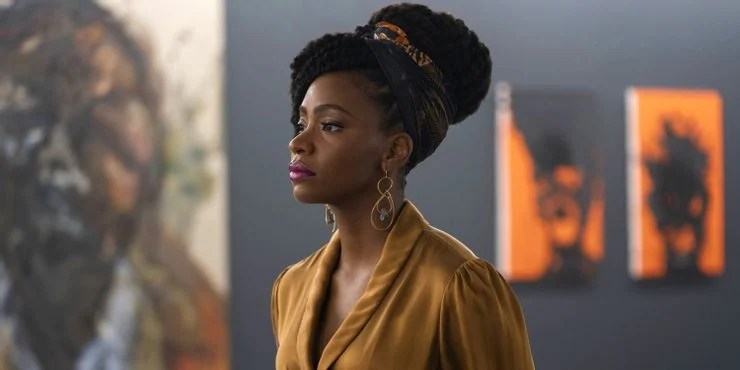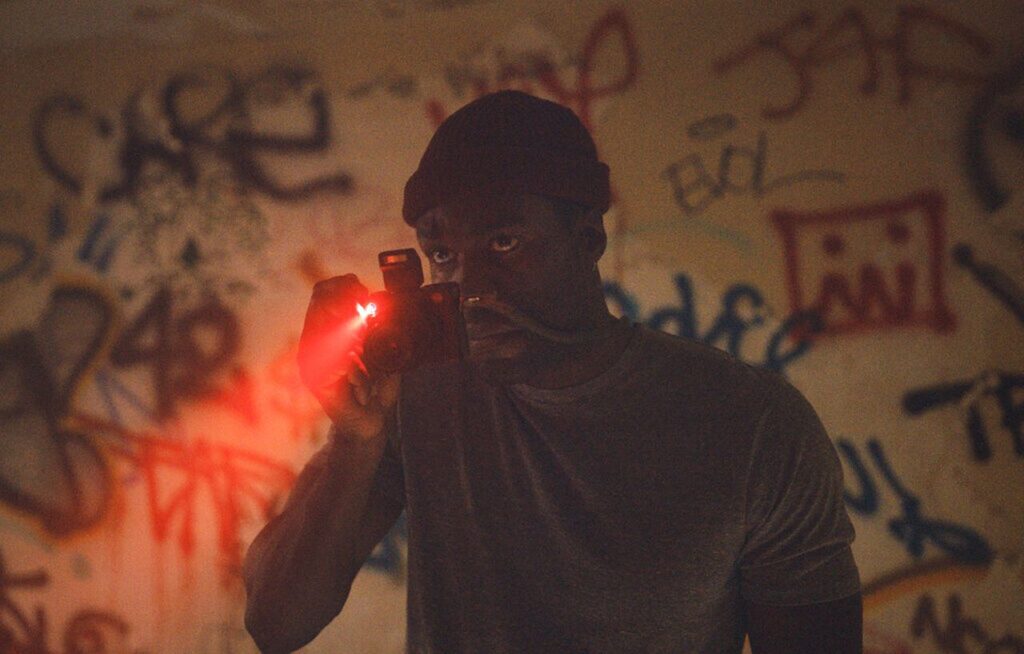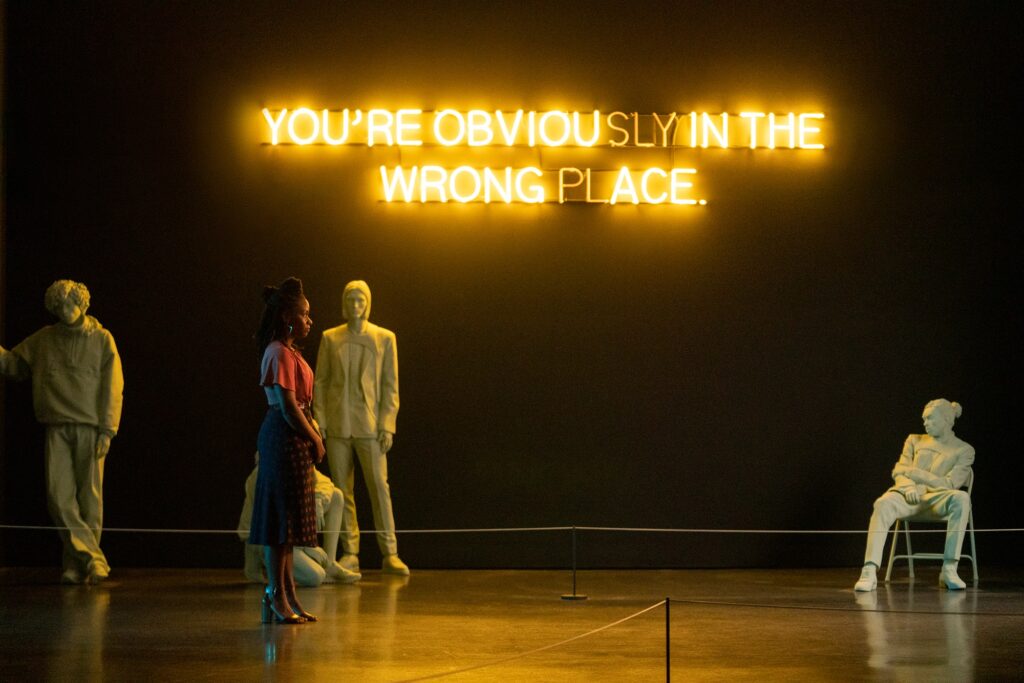Experience, Witness, Record: Legacy and Black Lives Lived in Circles in ‘Candyman’

This piece contains major spoilers for Candyman (2021).
Free will is a comforting concept that allows humans to maintain a modicum of control over their destinies. An often overlooked caveat to choosing one’s life path is the role personal legacies play in these decisions coming to fruition. Sometimes, no matter what choices are made, a person’s legacy may intervene and shape their future more so than their individual decisions.
Both Anthony McCoy and Brianna Cartwright, the main characters in Nia DaCosta’s Candyman, found themselves on circuitous paths first moving away from their childhood pain and then right back to where they started: experiencing, witnessing, and recording Black trauma. The events of the movie served as a template for Black lives lived in circles. This path is necessary for doing the painful and critical work of calling out and mitigating future trauma in Black lives.
Related: “Be My Victim”: Nia DaCosta’s ‘Candyman’ and The Insidious History of Racism In the United States
McCoy and Cartwright are young, upwardly mobile, Black professionals. Both had attended college and settled into a life blessed by their financial and social abilities to live in an upscale apartment in a gentrified part of Chicago. Cartwright spends her time making her mark in the art world as an influential art director. McCoy was ais a bright and promising artist who struggles with maintaining fame and creating consistently groundbreaking visual art. Although Anthony’s star seems to be on a downward path as Brianna’s is ascending, viewers understand Anthony’s setbacks can be temporary. He continues to work and simply needs the perfect creative inspiration to prevent his person and his work from fading into ignominy.
After all, Anthony has done everything the “right” way. He was raised in a neighborhood removed from the inner city he and his mother escaped following their personal tragedy; he attended college; and he hitched his trailer to an upwardly mobile partner in Brianna. Contrarily, a flashback to Brianna’s childhood shows her residing in what seems to be an inner-city apartment, where we can guess she may have remained after her father’s death. She rose above the stigma of a child rendered fatherless through suicide and became a woman who was in control of her own positive future. She also had done everything the “right” way.
Related: Why Monkeypaw Productions Didn’t Want a Known Horror Director to Helm ‘Candyman’

The choices each made which led them to the privileged lives we are introduced to in Candyman were formed on foundations of childhoods mired in poverty and trauma. The trappings of wealth surrounded the young couple in their new apartment in the gentrified area of Chicago, which looked nothing like the apartment we know McCoy resided in as a baby and the abode where Cartwright witnessed her father’s suicide. Just as the new building sought to erase the urban neighborhoods it covered, Cartwright and McCoy’s new lives should have served to erase their traumatic upbringings.
But the events in Candyman did not provide the erasure they sought. Instead, the plot brings the couple to ends they were destined to meet.
McCoy’s legacy as a baby kidnapped by the original Candyman hovered in the recesses of his subconscious his entire life. It is not until he hears the story of Helen Lyle that something inside his creative eye comes alive. He is inspired to track down the details of the story in order to fulfill the inspiration he suddenly felt to again create art. During this journey to discovering the truth around the legend and creating life-changing work, McCoy’s physical and mental conditions descend into a decaying and monstrous parody of the man his choices should have led him to become. The works birthed of his downward spiral into madness bring him the fame he desperately seeks; he can finally take his place as an iconic artist.
Related: ‘Candyman’ Review: Nia DaCosta’s Film Will Terrify a New Generation of Viewers
However, this is not his legacy. Instead, he witnesses the re-awakening of the legend of Candyman and plays an integral role in that rebirth. By the end of his life, he literally becomes the latest iteration of the legend with a different story that would be told with his name—one marred by murder and destruction rather than creation and life. McCoy experiences and records the Black agony of the Candyman before him—and that of his own trauma—through his art, death, and resurrection.
Cartwright’s story begins with her witnessing the suicide of her father, himself a troubled artist. Every move she makes in the art world is her effort to create distance between the legacy her father left with his suffering and the glowing reputation she wants for herself. She loves McCoy and from the beginning of the movie, seems willing to continue supporting him unconditionally through his dry spell. When McCoy’s actions become violent, her brother tells her she does not have to be drawn to troubled artists. He is wrong.

It was Cartwright’s legacy to witness the culmination of despair in her father through his work and death. She also witnessed the suicide that ended his suffering; this event predisposed Cartwright to experience McCoy’s agony and death years later. Her role as witness and record keeper of the effects of living under the unique pressures of Black people had on two of the most important Black men in her life ensured their stories were remembered and told, by her, cementing them and their lives in history. It is her legacy to become the art director for the installation depicting their lives.
Related: Who is ‘Candyman’? New Featurette Explores the Iconic Horror Villain
Their circular routes are necessary in recording and recognizing Black torment. They’re also necessary in ensuring the pain is not erased, ignored, or diluted in retellings and documentation. In a society determined to obscure all utterances of well-documented, factual racism and slavery, witnessing and recording have become instrumental in accurately reporting events in Black lives. Cell phones document misdeeds perpetuated upon Black bodies. Black creatives pour out their records of Black struggles into their works for screen, print, and other artistic venues. Despite calls to hide the details of this trauma, the stories and the emotions of these systemic evils must be revealed lest they be hidden away as if they never happened—as if they do not currently prevail.
Keeping Black pain in the spotlight, regardless of the discomfort it causes, is critical in mitigating future Black suffering. Only when racism is fully recognized and reckoned with will up-and-coming young Black people like Anthony McCoy and Brianna Cartwright be truly free to shake off the shackles of Black lives lived in circles around experiencing, witnessing, and recording Black trauma. Then they will be able to make real progress and move forward along the path of upward mobility and happiness that the opening of Candyman promises them. Until then, we must continue to say their names and tell their unadulterated stories.
Categorized:Editorials

